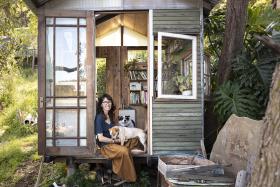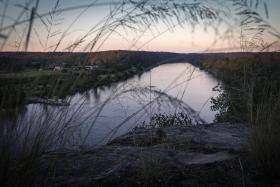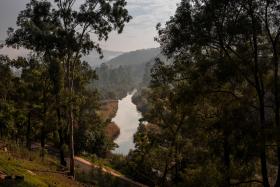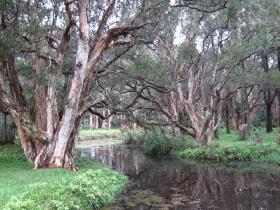Let me tell you about a place where I began again. Where I will always be beginning.
Here. Dyarubbin, the Hawkesbury River, traditional land of the Darug people. Upriver from Brooklyn, where the water is wide and quiet. A place of mud, mangroves and green-brown-black water; of sandstone cliffs and sea eagles arcing across shining skies.
Here is a place I didn’t know I needed to be.
Long ago I was told by a tarot reader with white-blonde hair and purple eyeshadow, in the storeroom of a vintage clothing shop on Enmore Road, that I would move north to a place of trees and water. I didn’t take much notice. Water was never something I thought I needed. She also told me, in-between informing impatient customers of the price of that leopard-print jumpsuit, that I would meet a man from another hemisphere, with daughters. My face, as usual, gave me away. ‘Maybe not daughters then, maybe female dogs’, she qualified swiftly. But no, daughters. And yes, water.
I grew up on a farm in central west New South Wales. A place gridded with notions of production — fences in straight lines, wheat and sheep (mostly) complying. Trees as punctuation marks, not paragraphs. This landscape, layered with stories as thick and complex as its rich, dark red-brown topsoil, is the bedrock of my being. I always imagined I’d return.
Between the farm and the river, between the headwaters and the estuary, I lived in the city. In a pretty place by the sea, an attic in a rambling old terrace, and a house with a wild peach tree in the courtyard. Fifteen years, and all that time I longed for soil, not concrete, under my feet. For hills, not tall buildings, tethering the horizon. For plant-life, not humanlife, pushing up against me.

In the city I met a man — the man from the north with two daughters. I settled into love. It, too, was a return of sorts. We moved to the river, after years of searching for soil that could grow a home. We happened upon this place by chance. A lucky meeting, a casual invitation, a confluence of needs.
‘If you’re looking for a challenge, there’s an abandoned house two doors down,’ our soon-to-be neighbour mentioned. We were visiting for lunch, having been introduced by their son, who told us about this settlement, about river life.
It seems we were looking for a challenge. Reaching the house from the path along the riverbank was adventure enough. Thirty years of neglect equals forest-infront-yard. We pushed our way through the wilderness. The house was unlocked, and we crept inside. Tiny, dark, curious. Half-finished bathroom complete with pink spa. 1990s kitchen with striped sky-blue benchtops. Wonky aluminium windows minus architraves. Paintsplattered timber floorboards and a rusted-out wood stove in the kitchen. Old timber windows with shattered glass panes opening out to the river. Broken bed frames, bookshelves heaving with romance novels, dust as thick as topsoil.
The bones were there, despite the mess. A 1950s river shack set gently in the landscape. A boatshed down on the riverbank, embraced by she-oaks. A wilderness of weeds.
We spoke on the phone with the owners. They agreed to sell.
The most dilapidated house on the most sinuous river sent my dreams of rolling hills and farmland downstream with the tide. We were on our way home to a life I had never imagined, an idea and a place that had never once floated through my mind as even a vague possibility. This life pinned to the edge of the river is not even obvious in hindsight. I am still surprised.
It is like we were pulled here. By the tide, the mangroves, the place itself.
We were pulled here. And now we work. Because to be the custodian of a place — whether a few metres or many — is a great privilege and responsibility. We’re fixing up the house and we’re removing the weeds and I’m gardening. And gardening and gardening. Not to make something new, but to make space for what is already here. The place, the plants, the stories.
It is in the garden next to the river that I come to understand a little of what it means to be here. And it is this: there is no such thing as an ending. Just endless beginnings, endless becomings.
The river and the soil, they will teach you this.
Georgina Reid is the editor and publisher of Wonderground print journal and The Planthunter online magazine: www.theplanthunter.com.au
This story appears in Openbook spring 2021.




